Can changes in midsole bending stiffness of shoes affect the onset of joint work redistribution during a prolonged run?
Ss Cigoj*,Jred R.Fletcher,Benno M.Nigg
a Human Performance Laboratory,Faculty of Kinesiology,University of Calgary,Calgary,AB T2N 1N4,Canada
b Department of Health and Physical Education,Mount Royal University,Calgary,AB T3E 6K6,Canada
Abstract Purpose:This study aimed to investigate if changing the midsole bending stiffness of athletic footwear can affect the onset of lower limb joint work redistribution during a prolonged run. Methods:Fifteen trained male runners(10-km time of <44 min)performed 10-km runs at 90%of their individual speed at lactate threshold(i.e.,when change in lactate exceeded 1 mmol/L during an incremental running test)in a control and stiff shoe condition on 2 occasions.Lower limb joint kinematics and kinetics were measured using a motion capture system and a force-instrumented treadmill.Data were acquired every 500 m. Results:Prolonged running resulted in a redistribution of positive joint work from distal to proximal joints in both shoe conditions.Compared to the beginning of the run,less positive work was performed at the ankle(approximately 9%;p ≤0.001)and more positive work was performed at the knee joint(approximately 17%;p ≤0.001)at the end of the run.When running in the stiff shoe condition,the onset of joint work redistribution at the ankle and knee joints occurred at a later point during the run. Conclusion:A delayed onset of joint work redistribution in the stiff condition may result in less activated muscle volume,because ankle plantar flexor muscles have shorter muscles fascicles and smaller cross-sectional areas compared to knee extensor muscles.Less active muscle volume could be related to previously reported decreases in metabolic cost when running in stiff footwear.These results contribute to the notion that footwear with increased stiffness likely results in reductions in metabolic cost by delaying joint work redistribution from distal to proximal joints.
Keywords: Fatigue;Footwear;Mechanics;Performance;Running
1.Introduction
A recent study reported that a prolonged (i.e., 10 km) run resulted in a redistribution of lower limb positive joint work,from distal (i.e., ankle) to more proximal (i.e., knee) joints,with increased running distance.1Sanno et al.1speculated that this redistribution occurred because ankle plantarflexor muscles might have fatigued to a greater extent during the prolonged run than the knee or hip extensor muscles.This was based on the notion that during the prolonged run calculated ankle joint moments were higher than calculated peak knee and hip joint moments relative to previously reported maximum joint moments assessed during isolated strength tests.2This confirmed previous reports of the higher relative efforts of the ankle extensors as compared to knee extensors during running.3The authors further speculated that a redistribution of positive lower limb joint work toward more proximal joints is disadvantageous for long-distance running performance because muscle-tendon units (MTUs) surrounding the ankle joint (e.g., triceps surae (TS) and Achilles tendon (AT)) are thought to be better equipped for storage and return of elastic energy than MTUs surrounding the knee joint.4This conclusion was made under the assumption that tendons can store and return relevant amounts of strain energy during running,4,5which may not necessarily be the case.6Furthermore, if prolonged running resulted in increased positive work at the knee joint and the MTUs surrounding this joint are not as well-equipped for energy storage and return, the additional work must be performed by the muscle in series with the tendon.7This muscle work would require a greater active muscle volume,thereby elevating the metabolic cost of running.7Thiscould be disadvantageous for long-distance running performance because metabolic cost is one of the key determinants of distance running performance,8and it increases as a function of running distance.9-11
It can be speculated that if the onset of lower limb joint work redistribution was delayed, performance benefits could be achieved as the direct result of a mitigated increase in metabolic cost during long-distance running events.One footwear feature that has been shown to have large effects on biomechanical,12physiological,13,14and performance15-17variables is the midsole bending stiffness (MBS).Although the underlying sources behind performance improvements achieved by running in footwear with increased MBS (by means of inserting stiff carbon fiber plates)are not-well understood,multiple mechanisms have been proposed to explain its function: (a) by minimizing energy loss,15(b) by storing and returning elastic energy,18,19(c)by optimizing the function of the major ankle plantarflexor muscles,20-22and(d)by way of the “teeter-totter” effect.23,24In brief, the principle of minimizing energy loss suggests that athletic performance can be improved by reducing the eccentric work performed by muscles.The principle of storing and returning elastic energy suggests that strain energy can be stored in the stiffening structures(e.g.,carbon fiber plates)of running shoe midsoles as the metatarsophalangeal (MTP) joint undergoes extension (i.e.,dorsiflexion).It is speculated that some of this stored energy is then returned to the athlete during the subsequent flexion of the MTP joint and recoil of the carbon fiber plates.The principle of optimizing ankle plantarflexor muscle function suggests that the TS muscle group is enabled to operate at slower shortening velocities when running in footwear with increased MBS due to changes in gear ratio25(i.e., the ratio between external and internal moment arms) and longer stance times;16,22,26this is thought to reduce the muscle energy cost.7Running in stiff footwear typically shifts the center of pressure further anteriorly during late stance.20This increases the moment arm of the ground reaction force to the ankle while the AT moment arm remains unchanged, and therefore increases the gear ratio.This increase in ratio between the external and internal moment arm is believed to allow the ankle plantarflexor muscles to operate on a more favorable position of their force-velocity relationship,27,28which has been speculated to improve the energy cost of running.20-22The “teeter-totter” effect suggests that the ground reaction force produces a force at the heel due to the curvature of the carbon fiber plate as the center of pressure travels anteriorly during the stance phase of running.This heel force is supposed to act at the right location (heel of the foot), at the right time(during push-off), and with the right frequency to reduce the metabolic cost of running.24
It was recently shown that running in footwear with increased MBS redistributed lower limb joint work from proximal to distal joints (i.e., opposite to the redistribution introduced by prolonged running).19Compared to running in a control shoe, Cigoja et al.19demonstrated that more positive work was performed at the MTP and less positive work was performed at the knee joint when running in stiff shoes.This was interpreted as a redistribution of positive lower limb joint work from proximal to distal joints; however, it remained unknown if such a redistribution could also be observed during a prolonged run and if it could be delayed by running in footwear with increased MBS.
For this reason, the purpose of the present study was to investigate whether running in shoes with increased MBS affects the onset of lower limb joint work redistribution from distal to proximal joints during a prolonged run.It was hypothesized that running with increased MBS would mitigate the lower limb joint work redistribution during a 10-km run.
2.Methods
2.1.Participants
Fifteen trained male runners (age=28.5 ± 6.7 years;height=1.79 ± 0.08 m; mass=70.6 ± 10.3 kg; mean ± SD)visited the laboratory on 3 separate occasions.Participants were included in this study if they reported the ability to run 10 km in less than 44 min,were free from lower limb injuries in the past 6 months, and fit Sizes 9, 10, or 11 US running shoes.This study was approved by the University of Calgary Conjoint Health Research Ethics Board(REB17-0171),and all subjects gave written informed consent prior to participating in this study.All procedures were performed in accordance with the Declaration of Helsinki.
2.2.Footwear conditions
The control condition (Control) consisted of a Nike Free Run 2018 (Nike Inc., Beaverton, OR, USA) shoe.The stiff condition was achieved by inserting straight carbon fiber plates between the factory insole and the midsole, and along the full length of the control shoe.The stiff condition,however,varied between participants: 7 participants ran in footwear with carbon fiber plates of 1.5 mm thickness(Stiff),and 8 participants ran in footwear with plates of 2 mm thickness (Stiffer).There were no significant differences between participants who ran in Stiff compared to participants who ran in Stiffer with respect to age (Stiff=27.4 ± 6.9 years; Stiffer=29.5 ±6.8 years; p=0.285), height (Stiff=1.78 ± 0.08 m; Stiffer=1.79 ± 0.08 m; p=0.390), mass (Stiff=67.1 ± 8.2 kg;Stiffer=73.7 ± 11.5; p=0.117), speed at lactate threshold(sLT; Stiff=4.25 ± 0.22 m/s; Stiffer=4.12 ± 0.20 m/s;p=0.132), or shoe size (Stiff:median=9, range:9-11;Stiffer:median=9, range: 9-11; p=0.430).The stiff condition differed between participants because previous studies have shown that there is a subject-specific optimal MBS of running shoes;29,30therefore,we sought to mitigate the risk of introducing a stiffness level that may be too low or too high for a given runner.Stiffer allowed us to compare the control shoe to a shoe with an extreme stiffness condition, which we speculated would result in large biomechanical effects during a prolonged run,whereas Stiff allowed us to compare the control shoe to a stiff footwear condition, one that is more likely to be encountered on the running footwear market.
The MBS of the shoe conditions was determined using a 3-point bending test.13,19In brief,the forefoot was placed on a structure with 2 supporting pins,which were 160 mm apart.A vertical,compressive force was applied in the area of the MTP joint using an ElectroPuls E10000 Linear-Torsion testing machine(Instron,Norwood,MA,USA).The machine was set to displace the shoe by 15 mm at a speed of 10 mm/s.This was repeated 10 times for all shoes conditions.The force and displacement data were filtered using a dual pass second-order Butterworth filter with a cut-off frequency of 5 Hz.The slope of the force-displacement curve(i.e.,stiffness)was determined for all 10 loading cycles.The stiffness values were first averaged between 70% and 90% of each loading curve (i.e.,linear portion of the force-displacement curve)and then across all 10 cycles.The MBS for Control, Stiff, and Stiffer were 1.58,6.46,and 13.28 N/mm,respectively.The footwear conditions were weight matched by inserting a total of 6 masses(i.e., 2 at the rearfoot, 2 at the midfoot, and 2 at the forefoot)into the control shoe.Across all conditions, the masses were 259, 280, and 296 g for the Size 9, 10, and 11 US shoes,respectively.
2.3.Data collection
2.3.1.Visit 1
On the 1st visit, the individual sLT was determined based on methods described elsewhere31while participants ran in the control shoes on a treadmill(Model Fully Instrumented Treadmill,Bertec Corp.,Columbus, OH,USA)with no gradient.In brief, participants first performed a 5-min warm-up at a self-selected speed.Immediately after the warm-up,a fingertip blood sample was taken to determine resting blood lactate concentration(Lactate Pro,Sports Resource Group Inc.,Minneapolis,MN, USA).After the warm-up, the treadmill belt speed was increased by 0.8 km/h every 2 min, after which blood lactate concentration was measured.This was repeated until blood lactate concentration rose more than 1 mmol/L from the previous s ample.The sLT was determined as the speed at the stage preceding the final stage.
2.3.2.Visits 2 and 3
On the 2nd and 3rd visits, respectively, participants performed a 10-km run at 90%of the individual sLT while wearing a control or stiff running shoe.The order of shoe conditions was balance randomized,so that 8 participants first ran in the control condition and 7 participants first ran in their stiff condition.Twenty-four retroreflective markers (diameter:12 mm)were applied to the pelvis and right lower limb according to methods described by Cigoja et al.19Except for the shoe,all markers were applied directly to the skin overlying anatomical landmarks.The shoe markers were applied on the upper material of the shoe.Three-dimensional kinematic and kinetic data of the pelvis and right lower limb were recorded at 200 Hz and 1000 Hz using 8 high-speed cameras (Vicon Motion Systems Ltd., Oxford, UK) and a force-instrumented treadmill (Model Fully Instrumented Treadmill, Bertec Corp.,Columbus, OH, USA), respectively.A 2-min familiarization trial was performed to allow participants to get accustomed to the running speed and footwear condition.Baseline kinematic and kinetic data were measured for 30 s immediately after the familiarization trial and subsequently recorded every 500 m during the 10-km runs.This resulted in 21 bouts of approximately 35-45 steps of the right leg, per subject and footwear condition.The stance phases(i.e.,where vertical ground reaction forces exceeded a threshold of 20 N32) of the middle 30 steps were identified and used for further analyses.
2.4.Data analysis
Raw data were analyzed using a custom written MATLAB code (Version 2019a; The MathWorks Inc., Natick, MA,USA).To determine the three-dimensional MTP, ankle, knee,and hip joint kinematics and kinetics, marker and force data were filtered using a dual pass second-order Butterworth filter with a cut-off frequency of 50 Hz.The cut-off frequency was determined based on a residual analysis33applied to marker trajectory data from 10 randomly chosen steps across all participants,shoe conditions,and distances.Then,the highest frequency across all markers was chosen as the cut-off frequency to guarantee that all relevant trajectory information was retained in the signal.Cardan angles were calculated to describe joint motion, and an inverse dynamics approach was used to estimate sagittal joint moments.Mechanical joint powers were calculated as the dot-product of joint moment and angular velocity.Positive and negative mechanical work were determined as the integral of the positive or negative joint power-time curves over the stance phase, respectively.Joint-specific positive work was expressed relative to total lower limb positive work performed during the stance phase of running.All variables of interest were first computed for each step across all participants, shoe conditions, and running distances.Then the variables were averaged across 30 steps, and the individual means were used for further comparisons between shoe conditions and running distances.
2.5.Statistics
Shapiro-Wilk tests were used to test for normal distributions of all dependent variables.The variables of interest were joint-specific positive work contribution relative to total positive lower limb joint work, stance times, peak flexion (i.e.,plantarflexion) moment, angular velocity and angle of the MTP joint,and peak extension moment, angular velocity,and angle of the ankle and knee joints.If variables were normally distributed, two-way repeated measures analysis of variance(ANOVA) was used to test for main effects of distance (i.e.,3 levels: 0 km, 5 km, and 10 km) and shoe condition (i.e., 2 levels: control and stiff), and for interaction effects between distance and shoe.Where significant (α=0.05) distance main effects or interactions were found, univariate repeated measures ANOVAs with 20 (i.e., 0 km vs.every other timepoint)paired Student’s t tests were performed for each shoe condition for each lower limb joint.If variables were not normally distributed,Friedman’s tests were performed to test for significant running distance effects for each shoe condition.MultipleWilcoxon signed-rank tests were then used where Friedman’s tests revealed significant distance effects.The significance level for multiple comparisons was adjusted using the Bonferroni correction and set to p=0.003 (i.e., p=0.05 ÷20=0.003).Effect size estimates were calculated using Cohen’s d.34The formula for calculating Cohen’s d was:
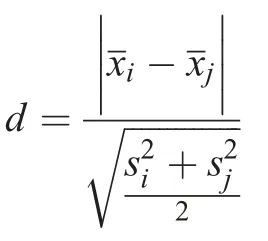

where σ is the sample standard deviation for each variable at baseline in the control condition and n is the sample size.
A mixed model ANOVA (between-subject factor: stiffness group (i.e., 2 levels: Stiff and Stiffer); within-subject factors:running distance (i.e., 3 levels: 0 km, 5 km, and 10 km) was used to test if joint work redistribution was affected differently in participants who ran in Stiff compared to Stiffer.Wilcoxon rank-sum tests were used to identify whether the change in joint-specific positive work from the beginning to the end of the run differed between participants who ran in Stiff compared to Stiffer.All statistical analyses were performed in SPSS Statistics Version 26.0(IBM Corp.,Armonk,NY,USA).
3.Results
Average sLT measured at Visit 1 was 4.18±0.22 m/s,which corresponded to 39 min 59 s±2 min 6 s on 10 km.The average running speed for Visits 2 and 3 (i.e., 90% of sLT) was 3.75 ±0.22 m/s,which corresponded to 44 min 36 s±2 min 50 s.
3.1.Relative joint work
There were no shoe (p=0.844), distance (p=0.784), or interaction effects(p=0.958)on total positive lower limb joint work during the runs.The two-way repeated measures ANOVA showed no significant interaction effect between shoe and distance for the positive work performed at the MTP (p=0.152), ankle (p=0.387), knee (p=0.535), or hip(p=0.777) joint.Significant distance main effects were found for the positive work performed at the MTP(p ≤0.001),ankle(p ≤0.001),knee(p ≤0.001),but not the hip(p=0.111)joint.Significant shoe effects were found for the positive work performed at the MTP (p ≤ 0.001) but not for the ankle(p=0.595),knee(p=0.883),or hip(p=0.491)joint(Table 1).
Friedman’s tests showed significant distance effects for the positive work performed at the MTP joint in the control(p ≤0.001) and stiff (p ≤0.001) conditions (Supplementary Table 1).In the control condition, positive MTP joint work decreased at 9 km (p=0.002, d=1.07) for the first time compared to 0 km (Fig.1).After correcting for multiple comparisons, no significant difference in positive MTP joint work was found for any timepoints compared to 0 km in the stiff condition (Table 1).Univariate tests showed significant distance effects on positive work at the ankle (control: p ≤0.001, stiff: p=0.001) and knee (control: p ≤0.001, stiff:p ≤0.001) joints for both conditions.In the control condition, positive ankle joint work was significantly different from baseline for the first time at 5 km (p=0.001, d=0.43)(Fig.2).In the stiff condition, positive ankle joint work was significantly reduced for the first time at 8 km (p=0.002,d=0.45).For the knee joint, positive work was increased for the first time at 5.5 km (p=0.001, d=0.28) and 7.5 km(p=0.002, d=0.34) in the control and stiff conditions,respectively (Fig.2).
3.2.Kinematics and kinetics
Significant shoe (p ≤0.001) and distance (p ≤0.001) main effects but no interaction(p=0.554)effects were found for stance time, with longer time observed in the stiff (216.58 ± 2.76 ms)compared to the control(210.00± 3.21 ms)condition,and with generally longer times(i.e.,control:+3.31%,stiff:+2.15%)with increasing running distance(Supplementary Table 2).Compared to the beginning of the run (control: 206.27 ± 18.47 ms; stiff:214.18 ± 16.83 ms), stance times was significantly longer at 10 km in both the control (213.11 ± 19.14 ms, p=0.001,d=0.36)and stiff(218.79±18.41 ms,p=0.003,d=0.26)conditions(Supplementary Table 2).

Table 1Positive MTP, ankle, knee, and hip joint work at 0 km, 5 km, and 10 km in the control and stiff shoe conditions relative to total positive lower limb joint work(mean±SD).
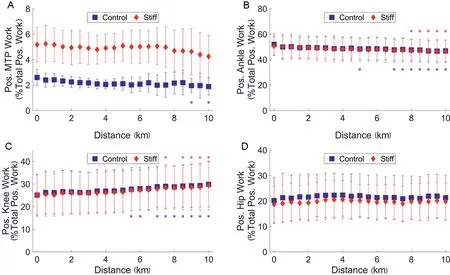
Fig.1.Mean±standard deviation positive metatarsophalangeal(A),ankle(B),knee(C),and hip(D)joint work in the control(blue squares)and stiff(red triangles)shoe condition during a 10-km run at 90%of individual speed at lactate threshold.*p ≤0.003,compared to the beginning of the run(i.e.,0 km).Pos.=positive;MTP=metatarsophalangeal.
Significant distance main effects were found for the peak MTP flexion moments in the control (p ≤0.001) and stiff(p ≤0.001) conditions (Supplementary Table 3).Compared to the start of the run (control: -0.88 ± 0.40 Nm/kg; stiff:-0.85 ± 0.26 Nm/kg; Fig.3), peak MTP flexion moments decreased in the stiff (-0.80 ± 0.27 Nm/kg, p=0.001,d=0.20) but not in the control (-0.82 ± 0.36 Nm/kg,p=0.009, d=0.17) condition after correcting for multiple comparisons (Supplementary Table 3).Significant main effects for distance (p ≤0.001) but not shoe (p=0.892) or interaction (p=0.937) were found for peak ankle extension moments (Supplementary Table 4).Compared to 0 km (control: -2.99 ± 0.53 Nm/kg; stiff: -2.96 ± 0.43 Nm/kg),ankle joint moments were lower in the control (-2.86 ±0.48 Nm/kg, p=0.001, d=0.27) but not stiff (-2.86 ±0.42 Nm/kg, p=0.010, d=0.22) condition at 10 km.Although significant distance (p ≤0.001) main effects were observed for peak knee extension moment, no significantdifferences were found between the beginning and end of the run after correcting for multiple comparisons (Supplementary Table 5).
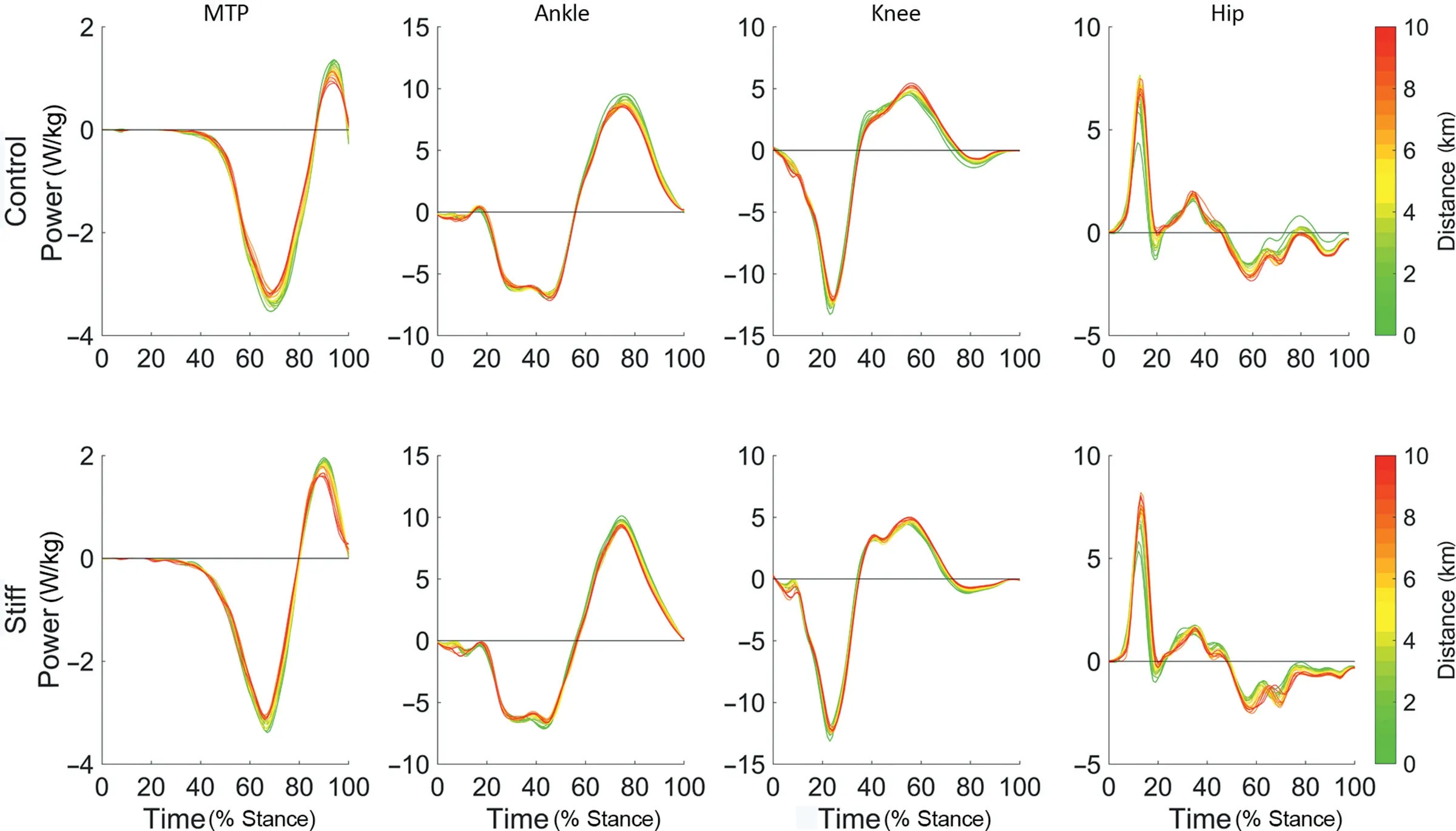
Fig.2.Ensemble mean (n=15) metatarsophalangeal, ankle, knee, and hip joint power over the stance phase of running at 90% of individual speed at lactate threshold for the control(top row)and stiff(bottom row)shoe conditions.Green,yellow,and red lines represent joint power at the beginning,middle,and end of the 10-km run,respectively.MTP=metatarsophalangeal.
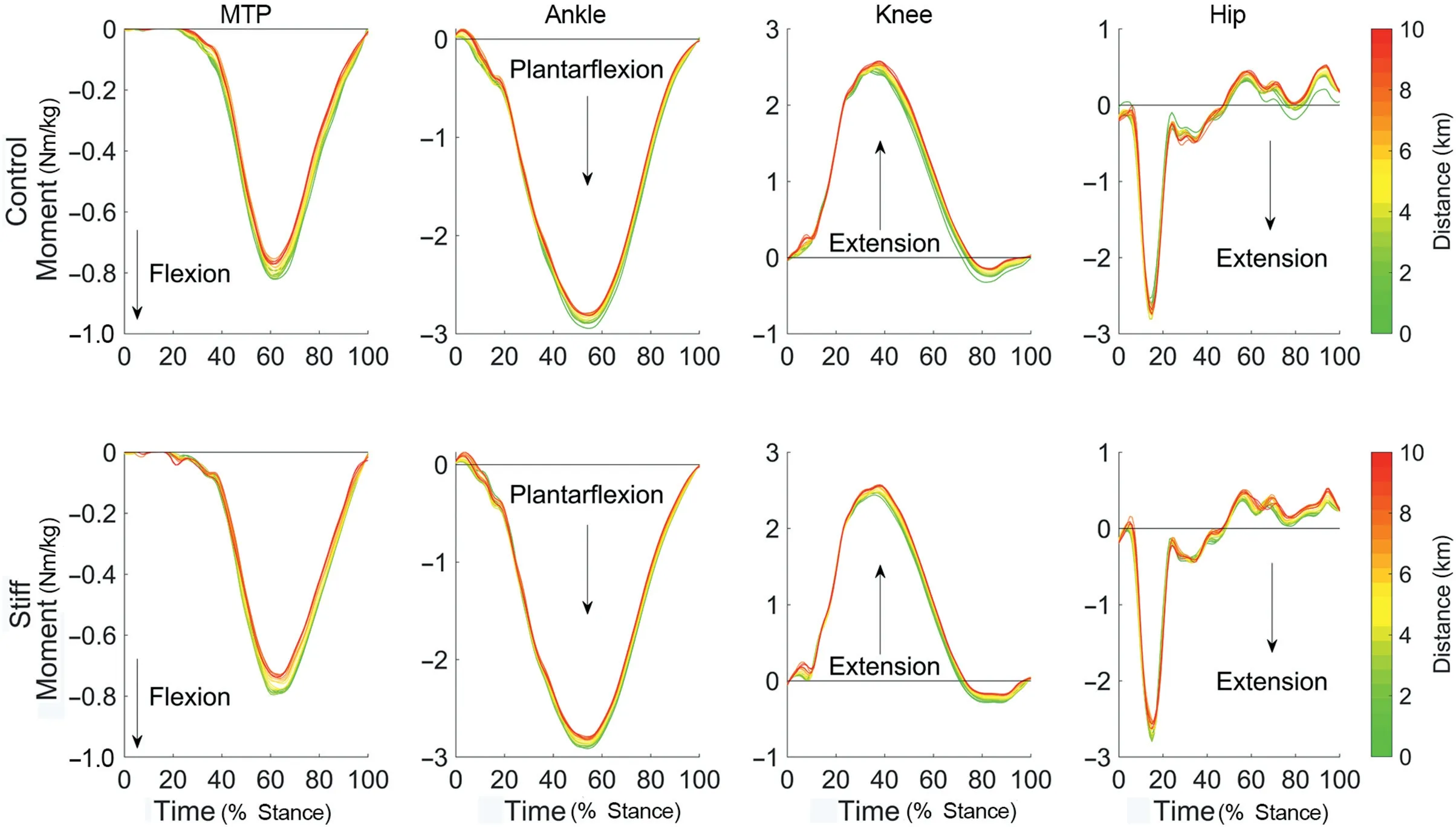
Fig.3.Ensemble mean (n=15) metatarsophalangeal, ankle, knee, and hip joint moments over the stance phase of running at 90% of individual speed at lactate threshold for the control(top row)and stiff(bottom row)shoe conditions.Green,yellow,and red lines represent joint moments at the beginning,middle,and end of the 10-km run,respectively.MTP=metatarsophalangeal.
Significant shoe (p ≤0.001), distance (p ≤0.001), and interaction (p ≤0.001) effects were found for peak MTP flexion velocity.Univariate tests revealed greater peak MTP flexion velocities in the control (-1023.31 ± 48.45 °/s) compared to the stiff(-816.17±6.89°/s)condition.Compared to the start of the run, peak MTP flexion velocities were higher at 8.5 km (p=0.002, d=0.57) in the control condition; no differences were observed in the stiff condition after correcting for multiple comparisons.Significant main effects of shoe(p=0.002) and distance (p=0.001) but not interaction(p=0.210)were found for peak ankle extension velocity.Peak ankle extension velocities were significantly lower in the stiff(-497.38 ± 7.55 °/s) than the control (-561.69 ± 11.94 °/s)condition.No shoe(p=0.893),distance(p=0.832),or interaction(p=0.648)effects were observed for peak knee extension velocities(Fig.4).
Significant distance effects were found for the peak MTP extension angle in the control(p ≤0.001)and stiff(p ≤0.001)conditions.Compared to the start of the run (control: 24.8 ±4.1;stiff:20.09±3.4°),peak MTP joint extension angles were significantly larger at the end of the run in the control(27.0±4.6°, p ≤0.001, d=0.52) but not in the stiff (21.43 ± 4.3°,p=0.008, d=0.35) condition (Fig.5).Significant distance(p ≤0.001) but no shoe (p=0.152) or interaction (p=0.785)effects were found for peak ankle extension angles.Compared to 0 km, peak ankle extension angles were higher at 8.5 km(p=0.003, d=0.58), 9 km (p=0.002, d=0.52), and 9.5 km(p=0.002, d=0.54) in the control condition, and at 9 km(p=0.003,d=0.59)in the stiff condition.Significant distance(p ≤0.001)but no shoe(p ≤0.001)or interaction(p=0.822)effects were found for peak knee flexion angles.Peak knee flexion angles were significantly lower in the control(-43.1±5.4°, p=0.003, d=0.26) but not in the stiff (-41.6 ± 4.7°,p=0.006, d=0.28) condition at the end compared to the beginning of the run (control: -41.6 ± 5.7°; stiff: -40.2 ±4.8°)(Fig.5).
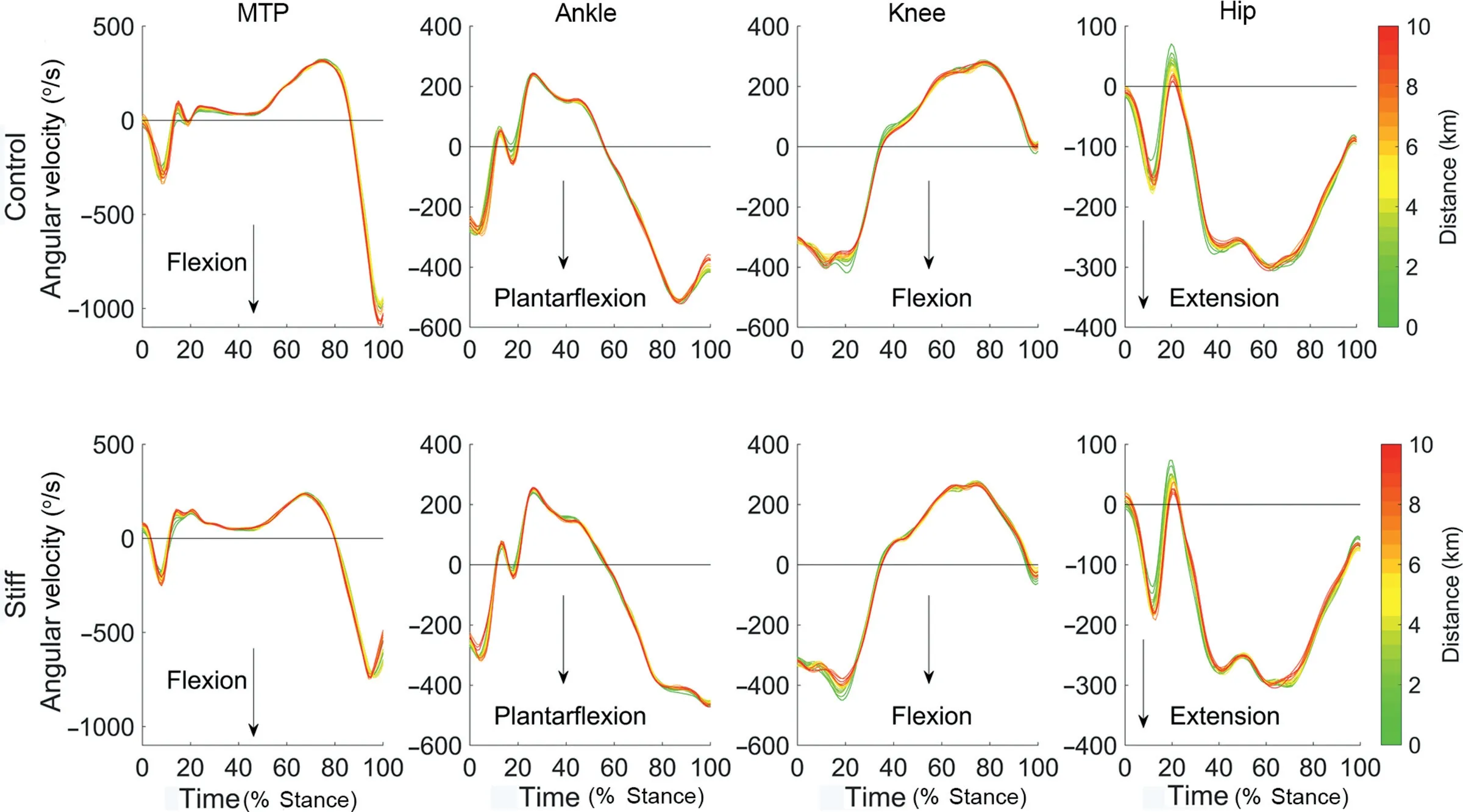
Fig.4.Ensemble mean(n=15)metatarsophalangeal,ankle,knee,and hip joint angular velocities over the stance phase of running at 90%of individual speed at lactate threshold for the control(top row)and stiff(bottom row)shoe conditions.Green,yellow,and red lines represent joint angular velocities at the beginning,middle,and end of the 10-km run,respectively.MTP=metatarsophalangeal.
There were no significant effects of distance (p=0.353) or shoe (p=0.869), and no interaction effects (p=0.405) on the striking pattern (i.e., determined as the sagittal plane ankle angle at heel-strike)(Supplementary Table 6).
3.3.Subgroup analysis
The mixed model ANOVA revealed significant distance effects on positive work performed at the MTP (p=0.003),ankle(p ≤0.001),and knee(p=0.001)but not hip(p=0.210)joint.There were no interaction effects between distance and stiffness group on positive work performed at the MTP (p=0.796), ankle (p=0.572), knee (p=0.775), or hip(p=0.469)joints.Furthermore,there was no effect of stiffness group on the positive work performed at the MTP(p=0.756),ankle (p=0.639), knee (p=0.731), and hip (p=0.296) joints.There was no difference in the change of joint-specific positive work contribution from the beginning to the end of the run between the participants who ran in Stiff compared to Stiffer for the MTP (p=0.867, d=0.04), ankle (p=0.536, d=0.08),knee (p=0.779, d=0.26), or hip (p=0.867, d=0.19) joints(Supplementary Tables 7 and 8).
4.Discussion
4.1.Muscle and tendon function
The purpose of this study was to investigate whether the onset of lower limb joint work redistribution from distal to proximal joints during a prolonged run can be affected by running in footwear with increased MBS.The findings of this study showed that the positive MTP and ankle joint work significantly decreased in the control condition from baseline at 9 km and 5 km, respectively; whereas, in the stiff condition,only positive ankle joint work decreased at 8 km with no significant changes at the MTP joint throughout the run.At the knee joint,positive work significantly increased from baseline at 5.5 km and 7.5 km for the control and stiff conditions,respectively.We interpret the finding that ankle joint work decreased while knee joint work increased sooner in the control condition than the stiff condition as an earlier onset of lower limb joint work redistribution.It needs to be acknowledged, however, that the interaction between shoe condition and distance was not significant,which could be related to the low sample size or use of different plates for the stiff condition.This delayed onset of redistribution in the stiff condition could be interpreted as a metabolically positive effect because a redistribution of positive work toward more proximal joints would require additional work to be performed by muscles surrounding these joints, thereby delaying the increase in metabolic cost normally seen during a run.Knee extensor muscles(i.e.,quadriceps)were reported to have longer muscle fascicles and larger cross-sectional areas compared to ankle extensor muscles (i.e., TS),36which would result in increased muscle volume activation.If similar activation levels between ankle and knee extensor muscles are assumed,it could then be speculated that greater active muscle volume would result in more adenosine triphosphate being consumed by the muscle, which could in turn increase the metabolic cost of muscle contractionand positive work generation.7This could have substantial implications for long-distance running performance, as the active muscle volume has been shown to be a major determinant of the metabolic cost of running.37Also, muscles with shorter fascicles have fewer sarcomeres in series and are thought to consume proportionally less adenosine triphosphate per unit force compared to muscles with longer fascicles under similar activation levels.27
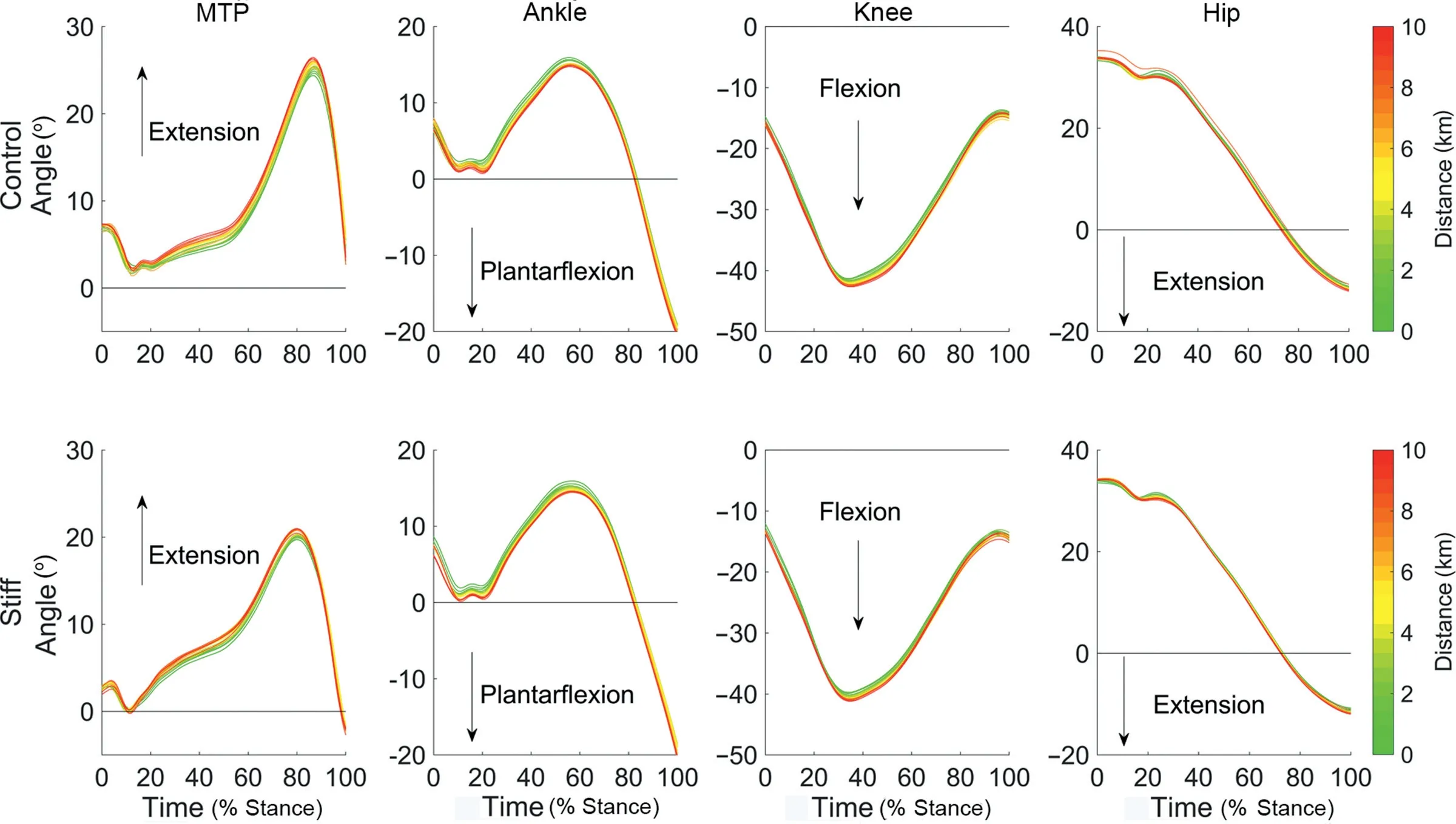
Fig.5.Ensemble mean (n=15) metatarsophalangeal, ankle, knee, and hip joint angles over the stance phase of running at 90% of individual speed at lactate threshold for the control(top row)and stiff(bottom row)shoe conditions.Green,yellow,and red lines represent joint angles at the beginning,middle,and end of the 10-km run,respectively.MTP=metatarsophalangeal.
Under the assumption that tendons are able to store and return relevant amounts of strain energy, a delayed onset of joint work redistribution toward more proximal joints when running in stiff shoes could potentially indicate that the AT returns energy to the athlete over an extended period of time,1thus reducing the need for additional muscle work.7A recent study from our laboratory investigated the effects of MBS on in vivo gastrocnemius medialis(GM)muscle fascicle behavior and estimated AT energy return.This unpublished study,which is currently under review, found that the GM muscle shortened less and with slower average shortening velocities when an individual was running in stiffer footwear.Ankle joint angles, however, remained similar between shoe conditions.This suggests that if the GM muscle shortened less but ankle angles did not change, the remaining shortening must have been performed by some other structure than the GM muscle.Based on findings from Lai et al.,38it seems that all 3 TS muscles function similarly (i.e., they shorten throughout stance) during running.Therefore, it is plausible to speculate that the AT performed the remaining “shortening” in the stiff condition to maintain the same ankle joint angles and return more strain energy.These results indicated that this additional energy return by the AT could allow the GM (and potentially the entire TS muscle) to operate on a more favorable position of the muscle’s force-length-velocity relationship.This has been hypothesized to reduce muscle fatigue and delay the onset of joint work redistribution, therefore mitigating the steady increases in the energy cost of running that are typically observed during long-distance running events.9-11,39
A recently published study investigated how running in footwear with differently stiff carbon fiber plates can affect the soleus muscle fascicle dynamics and running economy.40The authors did not find any differences in soleus fascicle pennation, force, length, velocity, or stride-average soleus active muscle volume due to altered MBS during running.Beck et al.40therefore concluded that inserting carbon fiber plates in shoes may not improve running economy.Even though it seems that the soleus muscle function was not altered by footwear of various MBS when running at 3.5 m/s, there are 2 major reasons as to why it would still be possible to see differences in muscle function in a setup similar to our study.First, although the individual TS muscles are thought to function similarly during running, Lai et al.38have demonstrated that there are subtle differences in fascicle length changes between the soleus and gastrocnemii muscles.Namely, the GM muscle fascicles exhibit the greatest length changes of all TS muscles during the stance phase of running.It is therefore reasonable to speculate that if changes in muscle fascicle shortening and/or shortening velocity exist between stiffness conditions, they are more likely to be found at a muscle with greater absolute length changes during stance.Meaningful differences in muscle function could still exist between stiffness conditions, but maybe not at the soleus.Second, Beck et al.40tested their participants while running at 3.5 m/s,whereas participants in our study ran at 90% of their individual sLT.Choosing a relative speed has the advantage that participants run at relative intensities, so it better represents their substrate utilization and energy yield per volume of oxygen.31At higher relative speeds and intensities, it is possible that differences in muscle function are likelier to be found at muscles containing more Type II (or fast-twitch) fibers.Muscles of different fiber type composition could therefore be affected differently by inserting carbon fiber plates in shoes during running.
The findings of this study showed that peak ankle extension moments decreased with increasing running distance.More importantly,these ankle joint moments started decreasing later in the stiff than in the control condition.This could be indicative of delayed fatigue of the major ankle plantarflexor muscles1when running in footwear with increased MBS.Additionally, peak ankle extension velocities were lower and stance times were longer in the stiff condition.If it is assumed that ankle extension velocities can be descriptive of ankle extensor MTU function,22,25these reduced velocities could indicate that the TS muscle and/or the AT operate at reduced shortening velocities.These speculations are supported by the increased stance times observed in this study when running in footwear with increased MBS,which would allow the MTU to shorten at slower velocities while maintaining similar shortening lengths.
4.2.Subgroup analysis
In this study, a subgroup analysis was performed to determine if running shoes with extremely stiff carbon fiber plates(i.e., Stiffer, 13.28 N/mm) would affect joint-specific positive work differently from the beginning to the end of a prolonged run when compared to a footwear condition with carbon fiber plates more likely to be found on the current sporting goods market (i.e., Stiff, 6.46 N/mm).The findings of this study showed no significant difference in joint-specific positive work changes from the beginning to the end of the run between Stiff and Stiffer.This suggests that a delayed onset of joint work redistribution can already be achieved by using carbon fiber plates of moderate bending stiffness.It needs to be noted,however, that the carbon fiber plates embedded in commercially available marathon racing shoes are typically curved near the MTP joint.The carbon fiber plates used in this study,however, were straight.Results from a preliminary study showed that ankle push-off moments were higher when running in shoes with straight compared to curved carbon fiber plates.41This suggests the likelihood that there are some differences in the functions of curved and straight carbon fiber plates.However, both curved14,16,17and straight plates13,30have been shown to improve the energy cost of running.Perhaps similar effects on the onset of lower limb joint work redistribution could be observed during a prolonged run incurrently available marathon racing shoes,which have curved carbon fiber plates embedded.The effects of plate curvature on running mechanics will need to be investigated in more detail by future studies.
4.3.Limitations
There are some limitations associated with this study.The sample used for comparing Stiff to Stiffer was low.This likely decreased the power of our statistical analysis, causing us to potentially underestimate the effects of differently stiff plates on joint work redistribution.Furthermore, not all participants were tested in all stiffness conditions.This would have allowed us to parse out subtle distinctions between different stiffnesses of carbon fiber plates.The control shoe used in this study had a low MBS.It is therefore possible that when running in other commercially available running shoes, which already have a higher MBS,the disparity in joint work redistribution may be smaller.The joint work considered in this study consisted of the sagittal plane work alone.Another recent study has shown that prolonged running can affect non-sagittal plane kinematics.42It is unknown, however, if these changes in non-sagittal plane kinematics can alter the total work performed at joints as no kinetics were reported.Our study only reported sagittal plane joint work because the main focus of this investigation was to estimate the contribution of the joint flexor/extensor muscle groups.Also, the sagittal plane work has been shown to be the major determinant of total joint work during human gait.43Furthermore, we did not control for the striking pattern of the runners.Although a recent study suggested that lower limb joint work may not be redistributed proximally during prolonged running in habitual rearfoot strikers,44our study confirmed previous findings from Sanno et al.1irrespective of striking pattern.Our analysis showed that the runners’ankles were in a dorsiflexed position at heelstrike, suggesting a rearfoot striking pattern (Supplementary Table 6).More important,however,there was no effect of distance or shoe,and no interaction effect on the striking pattern.The changes in positive lower limb joint work from the beginning to the end of the run were -5.14% and 4.76% for the ankle and knee joints, respectively.This is smaller than the minimal detectible change, which is likely related to the high between-subject variability in relative joint work contributions when running over a prolonged distance;however,the order of magnitude is well comparable to the findings by Sanno et al.1(i.e.,ankle:8%;knee:4%).The changes in relative joint work due to running in differently stiff shoes were of smaller magnitude than the changes observed due to the prolonged run(Table 1).This, however, was expected based on previously reported findings by Cigoja et al.19Furthermore, we applied markers directly on the skin overlying anatomical landmarks,which may have resulted in vibration of the markers during running.This vibration, however, can be considered similar between shoe conditions and running distances as marker placements did not change.Therefore, marker vibrations are unlikely to have affected the conclusions of this study.Lastly,we did not directly assess muscle and/or whole-body metabolic cost over the course of the prolonged run in both footwear conditions.Ultrasound imaging of the TS muscle(or its individual muscles)or of the AT would have enabled us to gain a deeper understanding of the ankle plantarflexor muscles and tendons,which would help with estimating the energy cost of muscle contraction and tendon energy return over the course of a prolonged run.45The results reported in this study should be interpreted in the context of these limitations.If feasible, future studies should attempt to record expired gases and in vivo TS muscle fascicle or AT behavior in order to determine the change in energy cost of running and to estimate muscle energy cost or tendon energy return.
5.Conclusion
Prolonged running in footwear with increased MBS resulted in a delayed onset of lower limb joint work redistribution from distal to proximal joints as compared to a control condition.This delayed onset of joint work redistribution toward more proximal joints could be metabolically beneficial because MTUs crossing distal joints are thought to be better equipped for elastic energy storage and return and have smaller muscle volume compared to MTUs crossing more proximal joints.Furthermore,this delayed onset of lower limb joint work redistribution could also be related to previously reported performance benefits when running in footwear with increased MBS.
Acknowledgment
This study was financially supported by the International Society of Biomechanics in Sports Student Mini Research Grant awarded to SC.
Authors’contributions
SC conceptualized the study,collected,processed,and analyzed the data, interpreted the results, and wrote the initial draft of the manuscript; JRF conceptualized the study, analyzed the data, interpreted the results, and revised the manuscript; BMN conceptualized the study, interpreted the results,and revised the manuscript.All authors have read and approved the final version of the manuscript, and agree with the order of presentation of the authors.
Competing interests
The authors declare that they have no competing interests.
Supplementary materials
Supplementary materials associated with this article can be found in the online version at doi:10.1016/j.jshs.2020.12.007.
 Journal of Sport and Health Science2022年3期
Journal of Sport and Health Science2022年3期
- Journal of Sport and Health Science的其它文章
- The secrets to running economy
- Metabolic and performance responses of male runners wearing 3 types of footwear:Nike Vaporfly 4%,Saucony Endorphin racing flats,and their own shoes
- Longitudinal bending stiffness does not affect running economy in Nike Vaporfly Shoes
- Metabolic cost of level,uphill,and downhill running in highly cushioned shoes with carbon-fiber plates
- Systematic reduction of leg muscle activity throughout a standard assessment of running footwear
- Neuromuscular,biomechanical,and energetic adjustments following repeated bouts of downhill running
